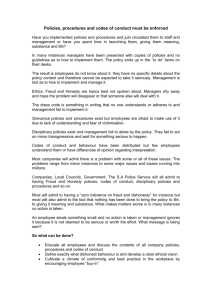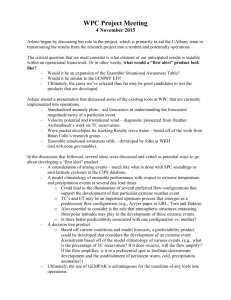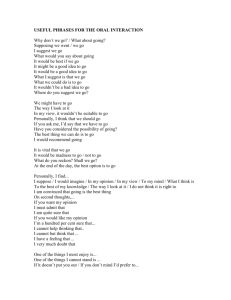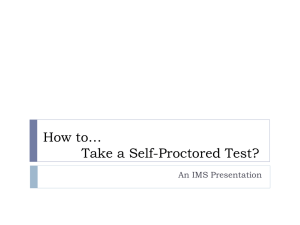Case Study Presentation - Haley's Dietetic Internship Portfolio
advertisement
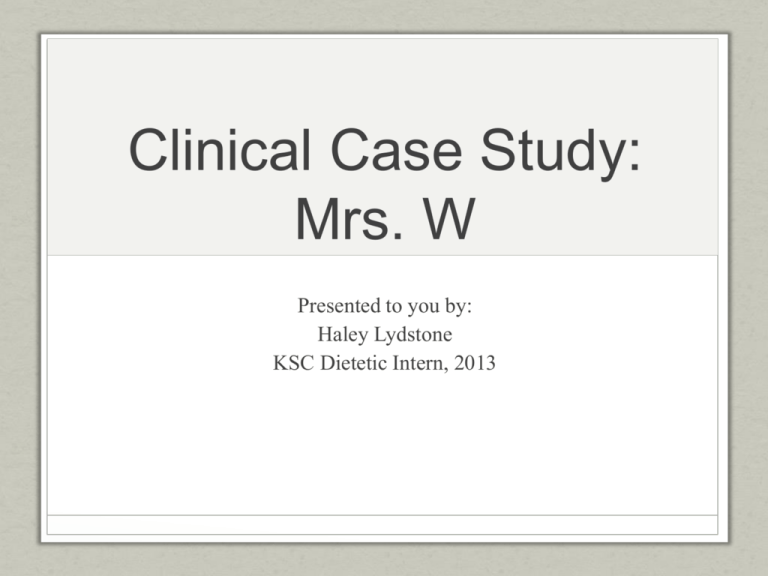
Clinical Case Study: Mrs. W Presented to you by: Haley Lydstone KSC Dietetic Intern, 2013 Whittier Rehabilitation Hospital (WRH) • Part of the Whittier Health Network • Has been providing health care services since 1982 • Located in Haverhill, MA • Long-term acute (LTAC) facility with 60 beds • Serves patients throughout New England • Provides inpatient, outpatient, pharmacist and home health services • Specialty care designed for medically complex patients who require a longer length of stay WRH Specialized clinics and programs: • Wound clinic • Memory clinic • Prosthetic/orthotic clinic • Day rehabilitation program • Auditory program Admission Criteria: • Age 16 or older • Significant change in functional status resulting from medical problem(s) • Medically stable & able to take part in rehabilitation activity Dietician’s Role at WRH • Provide nutrition care to patients in various disease states and conditions • Maximize nutritional support • Avoid delayed healing, speed up recovery, and minimize extended hospital stays • Monitor, assess and optimize nutrition status based upon current condition/nutrition adequacy • Provide education as needed • Making choices to speed up recovery process, prevent disease and maintain a healthy lifestyle • Confer with physicians and other health care professionals • Medical and nutritional needs, recommendations for tube feeds and EN and PN, and dietary supplements Case Study: Mrs. W Mrs. W Prior to admission to WRH: • Stroke occurred on 2/24/13 • Pt. was giving speech, experienced facial droop and slurred speech • Lawrence General: Quick treatment with vitamin K • Beth Israel: Pt. experiencing tachycardia and hypernatremia • 2/24: Had L. craniotomy • Complications: 3/1: UTI, 3/6: PEG placement, 3/10: pneumonia Meet Mrs. W Admit to WRH: 3/11/13 • 72 y.o. African American, female • 5’7”, 171.6# • IBW: 135#, 61 kg. • %IBW: 126% • BMI: 26.9, overweight • Near coma, pt. unresponsive, NKFA • Currently NPO on TF Initial Admit to WRH Admitting diagnosis: As a result: • S/p left craniostomy for evacuation of left intraparenchymal hemorrhage • PEG tube placement • L. facial droop • Global aphasia • Dysphagia • CAT scan • Hydrocephalus • Afib Hx of anticoagulation w/ coumadin Craniotomy Image retrieved from: www.hopkinsmedicine.org Intracranial Hemorrhage Intracranial Hemorrhage Image retrieved from: Iranian Red Crescent Medical Journal, http://ircmj.com/?page=article&article_id=1686 Pathophysiology S/p left craniostomy for evacuation of left intraparenchymal hemorrhage • Craniostomy: The surgical removal of part of the bone from the skull to expose the brain • Relieving pressure within the brain by removing damaged or swollen areas of the brain that may be caused by traumatic injury, or in Mrs. W’s case, a stroke www.hopkinsmedicine.org • Intracranial bleeding (hemorrhage) • Usually caused by head trauma • Intraparenchymal hematoma: occurs when blood pools in the brain • Progressive decline in consciousness MNT ICH/Stroke: • Maintain adequate nutrition • Weights, TF tolerance, TF meeting needs • Assess and manage dysphagia • Vitamin and mineral supplementation as needed • EN support as needed Reference: Mahan, L.K., Escott-Stump, S., Raymond, J.L. (2012). Krause’s Food and the Nutrition Care Process. 934-935. St. Louis, MI. MNT Dysphagia: • Main concerns: weight loss & anorexia • Minimalize conversations during meal time • Long meal duration & coughing • Adjust consistencies to meet patient’s needs • NPO: 3/12Puree/NTL: 3/26 Puree/thin lix: 4/8 House-MS cut/thin: 4/17 House-MS cut: 4/29 Reference: Mahan, L.K., Escott-Stump, S., Raymond, J.L. (2012). Krause’s Food and the Nutrition Care Process. 929-931. St. Louis, MI Initial Admit to WRH Medical History: Nutrition Diagnosis: • HTN • Hyperlipidemia “ Difficulty swallowing R/T ICH, dysphagia, AEB need for enteral feeds/SLP evaluation ” • Breast cancer • • BKR • Pt. at risk for malnutrition • TIA, “mini stroke” • Unknown weight loss, pt. poor historian Status: 3, High risk Initial Admit to WRH Medications List: • Amiodarone: heart rate • (Anti-arrhythmic) • Diltiazem: anti-HTN • Colace & Senna: constipation • MVI • Prevacid • Humulin: SSI low dose • Levofloxacin: ABX, (tx of PNA) • Metoprolol: BP • Pravastatin: Cholesterol • Provigil: increases alertness * Anti-depressants Initial Admit to WRH Calculated Needs: Current TF: • IBW: 135#, 61 kg. • Promote w/ fiber @ 60 mL/hour for 24 hours • Calories: 25-30 kcals/kg • 1535-1840 kcals • Protein: 1.2-1.5 g/kg • 73-92 g. protein • Fluid: 1 mL/kcal • 1535-1840 mL fluid • 1440 kcals, 90 g. protein, 1196 free water w/ 250 ml water flushes Q6, total water 2196 mL Initial Admit to WRH: Labs 3/12/13 3/13/13 • No new wt. • No new wt. • Albumin: 2.8 • Na: 146 • Prealbumin: 17.2 • Na: 138 • BUN/Cr: 17/0.6 • Glucose: 129 • Hemoglobin A1C: 5.9 • Glucose: 138 • FSs: 100’s 3/14/13: Tested – for CDiff 3/20/13 • 168.3#, 3# wt. • Alb: 2.8, FSs 100s (no coverage) Initial Admit to WRH 3/26/13 3/29/13 • TF change • Puree/NTL for lunch with SFG, 1:1 spv. • Trialing foods with SLP • Bolus feeds • 240 mL Jevity 1.5, 4x/day pgt. • Promod 30 mL BID • 240 mL Jevity 1.5 4x/day pgt. 30 mL promod BID • Will hold bolus if pt. consumes >50% of meal 3/31/13 • Pt. out acute, chest pain, elevated D-dimer & pneumoperiteum Initial Admit Summary • Frequent team work: MD, SLP, OT/PT & Dietician • Pt. tolerated TF well; started small amounts of PO • Status remained at a 3 throughout hospital stay (high risk) • Trialing Puree/NTL with SLP, also in SFG • Overall poor PO intake • Poor cognition • Wt’s remained relatively stable • 3 #’s in approx. 3 weeks, 2% (not clinically significant) * Pt. out acute to Beth Israel Mrs. W: Out Acute at BI • CT of head • Resolution of ICH, no new evidence of hemorrhage or edema • Contract radiograph of PEG • No evidence of leak • LFTs, CBC, CMP, blood cultures all normal Image displays resolved ICH, decreased IVH and decreased hydrocephalus Second Admit to WRH Readmitted: 4/3/13 Admitting Diagnosis: • Chest/abdominal pain with pneumoperitoneum secondary to PEG (chronic), difficulty communicating. * New dx: GERD, pt. presented w/ loose stools (per therapies) • Readmit main reason: Tx for stroke Nutrition Diagnosis: • “Difficulty swallowing R/T ICH AEB SLP evaluation/NPO status/ trialing dysphagia diet (puree/NTL) upon last admission.” • “Altered GI function R/T potential PEG issue/pneumoperitoneum AEB reported loose stools, hx constipation, abdominal pain, new dx of GERD” • Status: 3, high risk Admit #2: Pathophysiology Pneumoperitoneum: • Gas within the peritoneal cavity • Presents as bowel injury after endoscopy • Chest/Abdominal pain: Etiology unclear • Possibly related to pneumoperitoneum MNT GERD • Main factors are caffeine, alcohol, tobacco and stress; avoid dietary irritants. Lifestyle changes include dietary changes, weight loss, smoking cessation and elevating the head of your bed. Multiple loose stools/diarrhea • Identifying the source (? Cdiff) • Adequate fluids and electrolytes • TF adjustments as needed • Regular diet as tolerated Reference: Mahan, L.K., Escott-Stump, S., Raymond, J.L. (2012). Krause’s Food and the Nutrition Care Process. 616-617. St. Louis, MI Second Admit to WRH Medications: • Oxycodone, pravastatin, prevacid, senna, colace, SSI low dose Recalculated needs: 4/3/13 Labs: • Albumin: 3.2 • Na/K: 141/4.4 • Wt: 170.4#, 77 kg. • BUN/Cr: 10/0.7 • Fluid: 1 mL/kcal • 1540-1925 mL’s/day • Glucose: 111 • Calories: 20-25 kcals/kg • 1540-1925 kcals/day • Ca: 9 • Protein (IBW): 1-1.3 g/kg • 61-79 g. protein/day 4/4/13: Pt. tested – for CDiff Second Admit to WRH Readmit tube feed order: • Isosource 1.5 @ 240 mL 4x/day (bolus) • 1420 calories, 60 g. protein, 720 mL free water New TF order, 4/3/13: • Osmolite 1.5 @ 70 cc x 10 hours (from 2000-0600) • Osmolite 1.5 120 mL TID pgt. (bolus) • 250 mL water flush QID • Provides: 1583 calories, 66 g. protein, 805 mL free water • Add Promod as needed Admit #2: Pertinent Dates 4/8/13 4/12/13 • Puree/thin @ BK & lunch w/ SLP • Same diet order • TF order remains the same; Hold bolus if intake >50% • Pt. experiencing abdominal pain, ? R/T reflux or G-tube site. • Intake improving • Considering calorie count with potential to d/c TF orders • No further abdominal pain complaints • LBM: 4/7, lg. loose • LBM: 4/11 • No new labs; FS’s 100s • 4/10 labs: K 4.4 • Wt.:173.4# • Wt.: 172.2# Pertinent Dates Cont’d 4/17/13 4/22/13 • House, MS cut/thin • Discussed pt. in RTC • Same TF order (nocturnal + bolus) • Neurologist & team D/C’d TF’s House MS cut thin • Only PO w/ SLP 2x/day • Cal. count initiated • Continue TF until able to increase PO • Wt.: 172 • Wt.: No new Admit #2: Pertinent Dates 4/27/13 • Pt. not meeting needs po (per calorie counts x 3days) • Pt. refusing all meals, ? secondary to stomach pain • Refused 4/25, 4/26 and BK on 4/27 (per SLP) • Recent hx constipation & loose stools • Prior TF order restarted (bolus only) • Pt. willing to eat BK at 915 am • Plan to bolus 200 mL Osmolite 1.5 if pt. eats <50% meals • Reassess 4/29 Admit #2: Pertinent Dates 4/29/13 • Pt. winces when GT touched (per nursing) • Diet change: House MS cut w/ 1:1 SPV, Mighty shake TID • Refluxed partial bolus • KUB: negative; stools for Cdiff: negative • Pt. not eating, refusing bolus • MD wanted to send pt. out acute for abdominal CAT scan • Pt. started on IV fluids • Wt.: 170.6 • 4/26: K 5.4 Admit #2: Pertinent Dates 4/29-5/2 • Poor tolerance for TFs & bolus, IVs started 4/30-5/1 • Received IV only 5/2/13 • Pt. out acute to BI for PEG evaluation Admit #2 Summary • Pt. readmitted with loose stools • KUB and Cdiff were negative • Pt. experiencing pain around PEG site • • MD’s wanted her to eat PO • Thought an increased appetite would prompt her to eat • RD and SLP were skeptical • Wincing when touched • Bolus refluxed • • Wt. stable, 170-173#s Status: remained 3 during stay TF’s D/C’d in attempt to stimulate appetite • Pt. “On strike” on a daily basis • Pt. on IV fluids secondary to bowel rest • Pt. discharged for PEG evaluation Out Acute to BI Mrs. W at BI from 5/2/13-5/6/13 • Abdominal pain secondary to malpositioned G-tube, with decreased flow • CAT scan: PEG placed in 2nd portion of duodenum; soreness around site • Supposed to be in stomach • PEG repositioned • Started on vancomycin secondary to soft tissue infection @ PEG site (observed for 2-3 days) • TF change: 1/2 can (120 mLs) 6x/day Q4hours Admit #3 5/6/13:Admitting dx: s/p PEG placement, CVA Pathophysiology: • PEG: routine in pt.’s unable to eat PO • Occurs when G-tube placed somewhere other than stomach • Pneumoperitoneum is an early indicator of malpositioned Gtube References: http://www.ncbi.nlm.nih.gov/pmc/articles/PMC2699054/, www.webmm.ahrq.gov Proper G-Tube Placement MNT S/p PEG readjustment/placement • Adjust TF to meet patient’s needs & avoid discomfort • Monitor: abdominal distension and comfort • • • • • I’s and O’s Gastric residuals Q4hours Stool output & consistency Labs (signs and symptoms of edema & dehydration) Weights, 3x/week Reference: Mahan, L.K., Escott-Stump, S., Raymond, J.L. (2012). Krause’s Food and the Nutrition Care Process. 308-312. St. Louis, MI Admit #3 5/7/13 Nutrition dx: “ Inadequate oral intake R/T cognitive status/recent abdominal pain/ AEB need for EN feeds pgt..” Status: 3, high risk Medications: • Keppra, nystatin, miralax, pravastatin, senna, SSI low dose, colace, MVI, prevacid Admit #3 Recalculated Needs: • Wt. 173.1#, 79 kg. IBW 135#, 61 kg. Admitting TF order: • 120 ml Jevity 1.5 QID Provides: • Calories: 20-25 kcals/kg • 1580-1975 calories/day • 710 cals, 30 g. protein, 360 ml free water, 120 ml water flush Q6 hours (480 ml), total water 840 ml • Protein: 1g/kg (IBW) • 61 g./day New TF order: • Fluid: 1ml/kcal • 1580-1975 ml/day • 120 ml TwoCal QID (6am, 10 am, 2 pm, 6 pm) Provides: • 950cals, 40 g. protein, 332 ml free water Pertinent Dates 5/6/13 • Pt. continued to have abdominal pain • Wt. 172.8# 5/7/13 • Started on 1:1 meals w/ SLP 5/9/13 • Pt. discussed in FTC • No new weight TF changed: Osmolite 1.2 @ 40 ml/hr x 20 hrs • Provides: 960 cals, 44 g. protein, 656 ml free water. Goal: Osmolite 1.2@60ml/hrx20 hrs; provides: 1440 cals, 67 g. protein, 984 free water 5/9: Family Team Conference Attendees: 3rd husband, son, daughter, family friend (Mrs. W’s best girlfriend), psychologist (family friend & priest), MD, RD, SLP, OT, PT FTC Summary: • Husband wants to take her home • Husband and son unsure about depression meds • Pt. attempted to leave WRH via vehicle w/ husband • Husband not fully understanding Mrs. W’s current issues Admit #3 5/10 5/23 • TF rate increased to 50 ml/hr x 20 hrs • No TF order changes • Provides: 1200 cals, 56 g. protein, 1400 ml free water w/ flushes • M/S cut thin TID 1:1 w/ SLP at BK and lunch • Tolerating TF well, minimal residuals • PO intake remains poor • Pt. consumed >50% of meal with friend present • Labs WNLs • Wt. 167.8# 3.2 # • Pt ate >75% BK this am • Will decrease TF volume to 750 ml: 900 calories, 42 g. protein x 10 hours Discharged to SNF • Pt discharged to SNF • MS cut 1:1 supervision • Nocturnal TFs: Osmolite 1.2 @ 75 ml/hr x 10 hours/day from 8 pm- 6 am WRH Pt. Plan 1. To progress pt. to PO status (RD, SLP, MD) 1. Made several attempts to increase appetite & stimulate intake 2. Meet patient’s needs with EN pending functioning PEG and tolerating bolus feeds 2. Work with family and friends to raise awareness of patient’s needs 3. Discharge to SNF on EN w/ some PO, 1:1 supervision Mrs. W: Life After WRH • Doing well at SNF • “closed facility” Pt. can ambulate freely around her room • Husband visits daily • Somewhere she can cook • Very supportive group of family and friends References • http://www.aphasia.net/info/aphasia/global_aphasia.htm • http://www.medicine.virginia.edu/clinical/departments/medicine/divisions/digestive-health/nutrition-supportteam/nutrition-articles/BanhArticle.pdf • http://openi.nlm.nih.gov/detailedresult.php?img=3004506_kjped-53-913-g002&req=4 • http://www.nutrition411.com/professional-learning/professional-refreshers/item/393-albumin-as-an-indicator-ofnutritional-status • http://www.strokecenter.org/professionals/stroke-management/for-pharmacists-counseling/pathophysiology-and-etiology/ • http://www.mayoclinic.com/health/intracranial-hematoma/DS00330/DSECTION=causes • www.meddean.luc.edu • http://www.whittierhealth.com/rehabilitation_hospitals/bradford.html • http://www.wjem.org/upload/admin/201108/6e21f8f9449aee76f10cda971f3b3bbd.pdf • Reference: Mahan, L.K., Escott-Stump, S., Raymond, J.L. (2012). Krause’s Food and the Nutrition Care Process. 616617. St. Louis, MI


